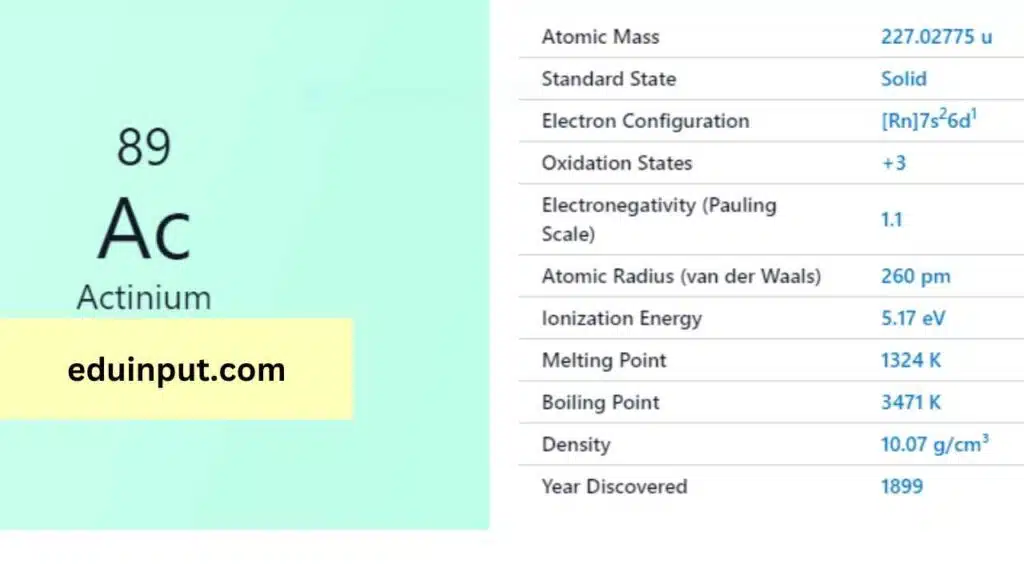Actinium-Discovery, Properties, And Applications
Actinium is a rare, silvery-white, radioactive element with the symbol ‘Ac’ and atomic number 89. It was discovered in 1899 by French chemist André-Louis Debierne, who named it after the Greek word ‘aktinos’ meaning ‘ray’. Actinium has few practical applications due to its high radioactivity, but it has found use in certain medical and industrial applications.
| Property | Value |
| Name | Actinium |
| Symbol | Ac |
| Atomic number | 89 |
| Relative atomic mass (Ar) | (longest-lived isotope) |
| Standard state | Solid at 298 K |
| Appearance | Silvery |
| Classification | Metallic |
| Group in periodic table | |
| Group name | Actinoid |
| Period in periodic table | 7 (actinoid) |
| Block in periodic table | f |
| Shell structure | 2.8.18.32.18.9.2 |
| CAS Registry | 7440-34-8 |

Discovery
Actinium was first discovered in 1899 by André-Louis Debierne, who extracted it from uranium ore. Debierne initially thought that he had discovered a new element, but it was later found to be identical to an element that had been independently discovered by Friedrich Oskar Giesel a few months earlier.
Physical Properties
Actinium is a highly radioactive element that is silvery-white in color. It is a soft, ductile metal that tarnishes quickly in air. Actinium has a density of 10.07 g/cm3, a melting point of 1,050°C, and a boiling point of 3,200°C.
Chemical Properties
Actinium is a highly reactive element that readily forms compounds with other elements. It reacts with air and water to form oxides and hydroxides and reacts with acids to form actinium salts. Actinium is a rare earth element, and its chemical properties are similar to those of other rare earth elements.
Facts
- Actinium is a highly radioactive element that emits alpha particles, beta particles, and gamma rays.
- Actinium is a rare earth element that is found in small quantities in uranium ores.
- Actinium has few practical applications due to its high radioactivity, but it has found use in certain medical and industrial applications.
Applications
Actinium has limited practical applications due to its high radioactivity, but it has found use in certain medical and industrial applications. Some of the major applications of actinium include:
- Medical Applications: Actinium has been studied for its potential use in cancer treatment. It emits alpha particles, which can be used to selectively destroy cancer cells while sparing healthy cells. Actinium-225 is currently being investigated as a potential treatment for various types of cancer.
- Industrial Applications: Actinium has been used as a neutron source in certain industrial applications, such as oil well logging and non-destructive testing. It has also been used as a radiation source in certain laboratory experiments.
Actinium is a rare, highly radioactive element that has limited practical applications due to its high radioactivity. However, its potential use in cancer treatment makes it an important element in the field of medicine. As technology continues to advance, the potential uses of actinium may expand, making it an important element for the future.







Leave a Reply